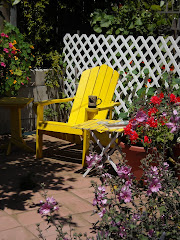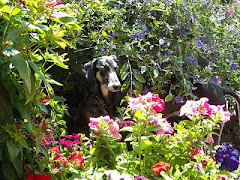The Legacy visitors were loaded on a bus for the drive up to the sacred Painted Rock. This was a meeting place for both Chumash and Yokut tribes (among others) both for trading and for ceremonial rites. The rock is a remnant of sandstone outcropping from a prehistoric inland sea. Its fragility (and historical and sacred importance to the Chumash) is one reason that since becoming a National Monument, a serious effort was made to repair, protect, restrict visitors.
Years ago, when the land was in private hands, little care was taken of the rock. Sheep were penned in its bowl-like center, generations of nincompoops carved or spray painted their initials on it, defacing the ancient pictographs within. The Getty Museum restoration team assisted in the work to repair the rock and much of the more recent graffiti was removed and restricted use will protect the rock as well as the nesting peregrines and hawks (and an owl) that call it home.
 Most of the remaining pictographs are tucked under some of the overhanging rock where they were protected from the elements.
Most of the remaining pictographs are tucked under some of the overhanging rock where they were protected from the elements. And, standing in the center of the rock and looking out into the valley, it's easy to see why this became a very special place to so many.
And, standing in the center of the rock and looking out into the valley, it's easy to see why this became a very special place to so many.  And, of course, no visit to the Carrizo would be complete without visiting its keystone species, the famed, endangered Kangaroo Rat. The rains have been late and/or nonexistent at his point, so the vegetation around their "precincts" was pretty scant. When the rains are abundant, the rat family cuts down a swath of grasses about 3' feet around his burrow (which territory they ferociously defend against another rat family with their nearby 3' circle.) The cut grass dries and as needed, the seed heads are dragged into the burrow for din-din. Recent aerial surveys have discovered that these circular precincts extend over a far wider swath of the plains than had been previously believed. Which is good news for an endangered species. And further research of this kind is also revealing just profound an impact the little grass-cutting critter has on the overall health of the plains and the other animals whose lives depend on that environment. Including the lovely kit fox who depends on the K-rat for food. Hence the rat's designation as "keystone."
And, of course, no visit to the Carrizo would be complete without visiting its keystone species, the famed, endangered Kangaroo Rat. The rains have been late and/or nonexistent at his point, so the vegetation around their "precincts" was pretty scant. When the rains are abundant, the rat family cuts down a swath of grasses about 3' feet around his burrow (which territory they ferociously defend against another rat family with their nearby 3' circle.) The cut grass dries and as needed, the seed heads are dragged into the burrow for din-din. Recent aerial surveys have discovered that these circular precincts extend over a far wider swath of the plains than had been previously believed. Which is good news for an endangered species. And further research of this kind is also revealing just profound an impact the little grass-cutting critter has on the overall health of the plains and the other animals whose lives depend on that environment. Including the lovely kit fox who depends on the K-rat for food. Hence the rat's designation as "keystone." At the center of the plains is the great Soda Lake. Since the rains have been so poor this year, there's lots of soda, very little lake.
But what would the Carrizo Plains be without the great Soda Lake. Since the rains were missing, the vast sheets of wildflowers were either still asleep or had already given up the ghost, or, if the rains come today and tomorrow, they may start their life cycle again. But the Carrizo dressed up in it's finery or sere and dry, is still a very special place of abiding. of endurance and great beauty.

















3 comments:
When the winds drive to the edge of soda lake it sends up a plume of white like it's burning. Thanks for the Photos, and story. A very special place.
Writing anonemously; I hope you brought back in a 2x4 green box or such, at least 3 mating pairs to re-populate the dunes.
Great story and photos! Thanks for the info!
Alon: Sorry, didn't see any little rats hopping around. Presume they were all snoozing in their "precincts." Did see the big owl that roosts in the sacred rock. And a very large herd of elk, which was a treat. No pronghorns, though. One of the docents said they're having a tough time getting re-started out there. The babies keep getting taken, likely by coyotes who are there to feast on the little rats. Which is odd since pronghorn babies are practically born running like the wind.
Post a Comment